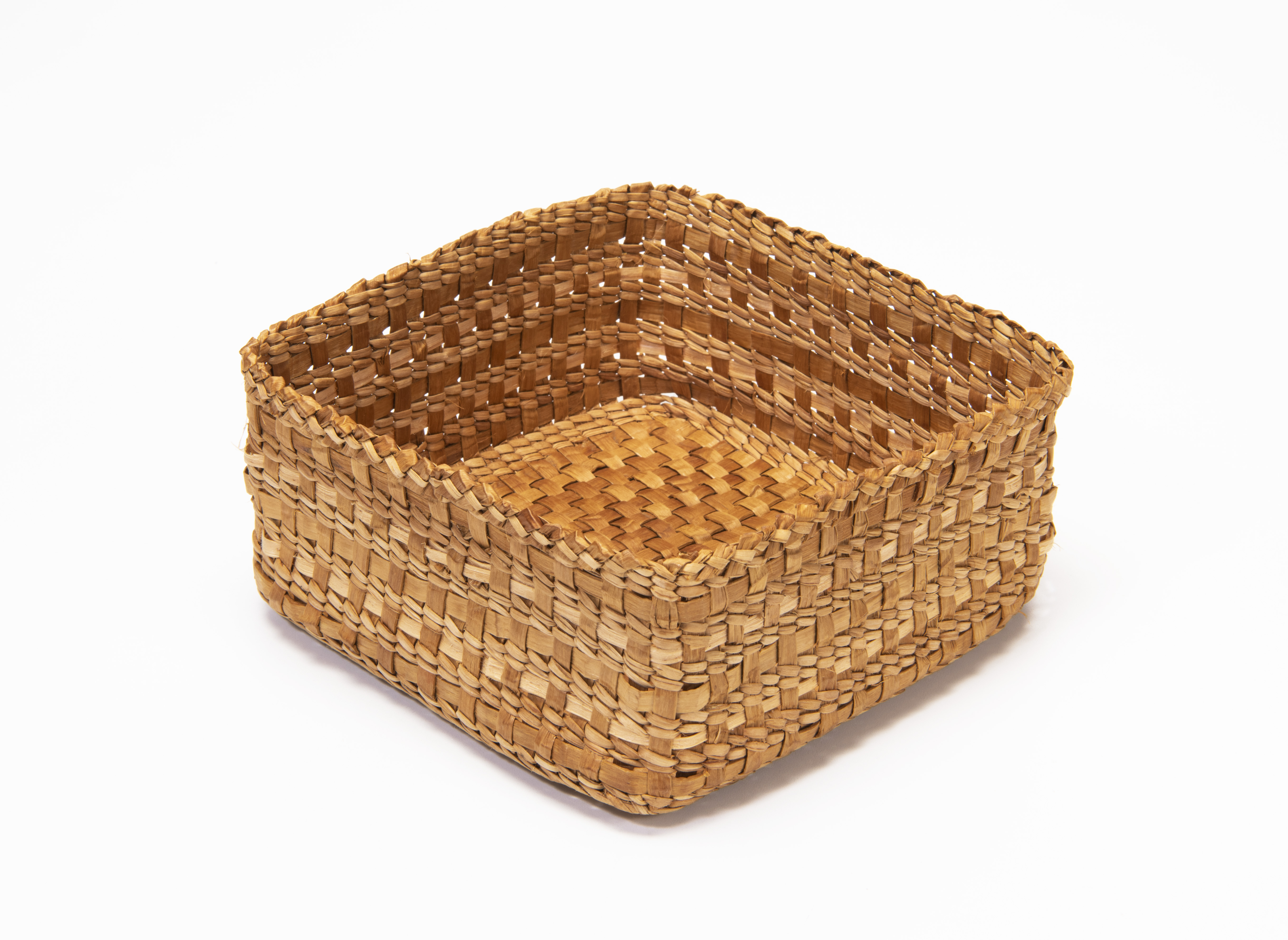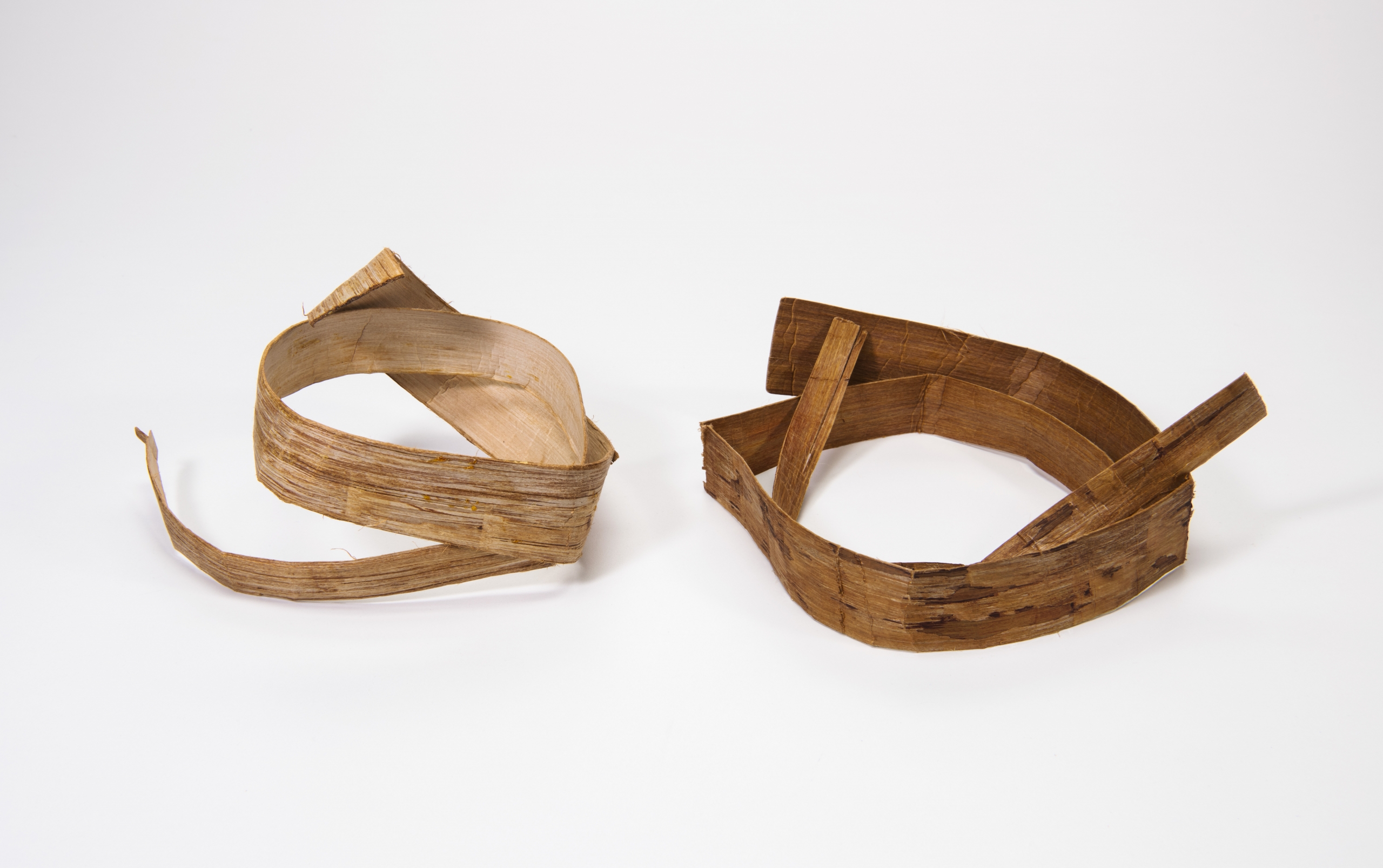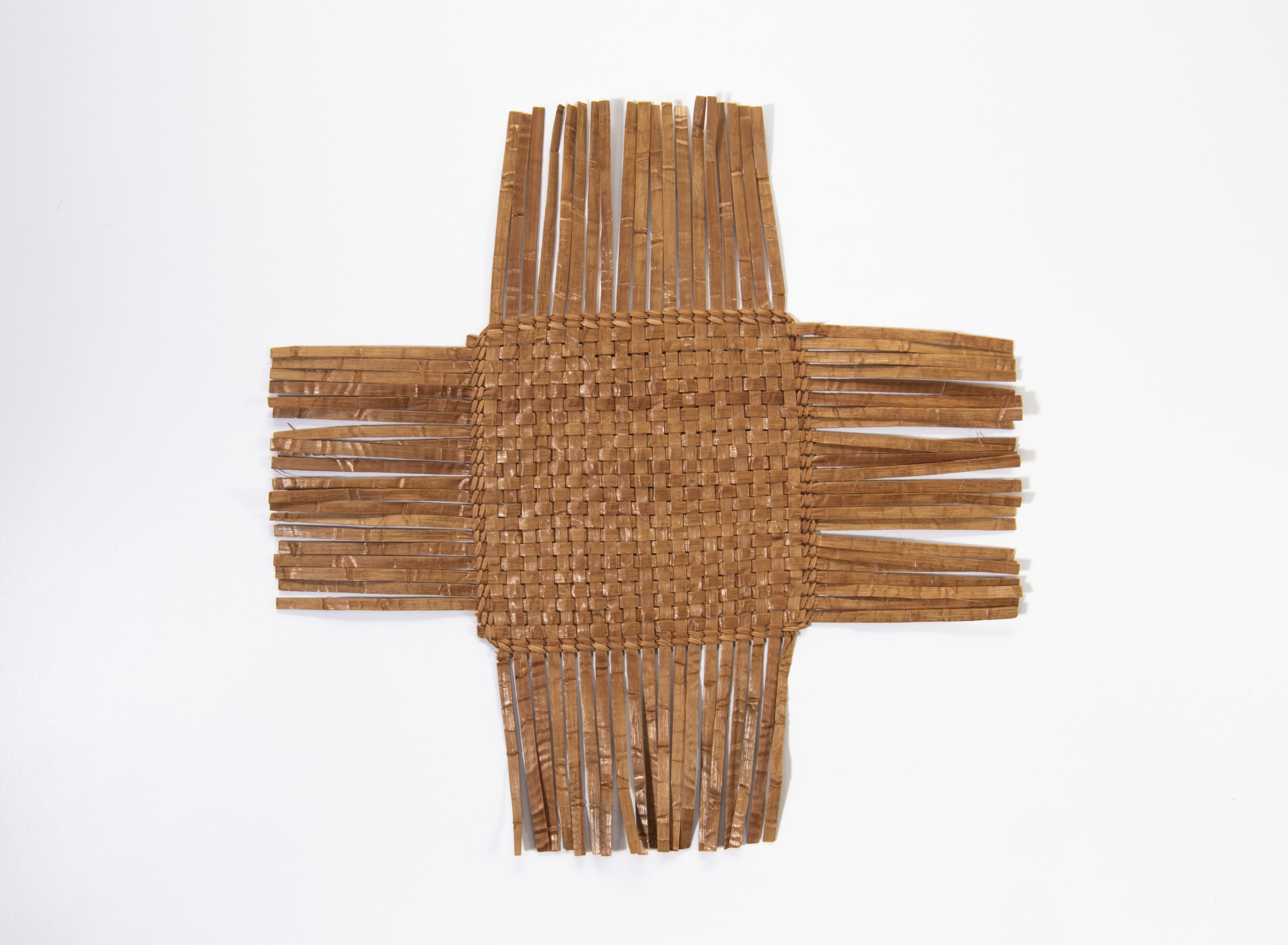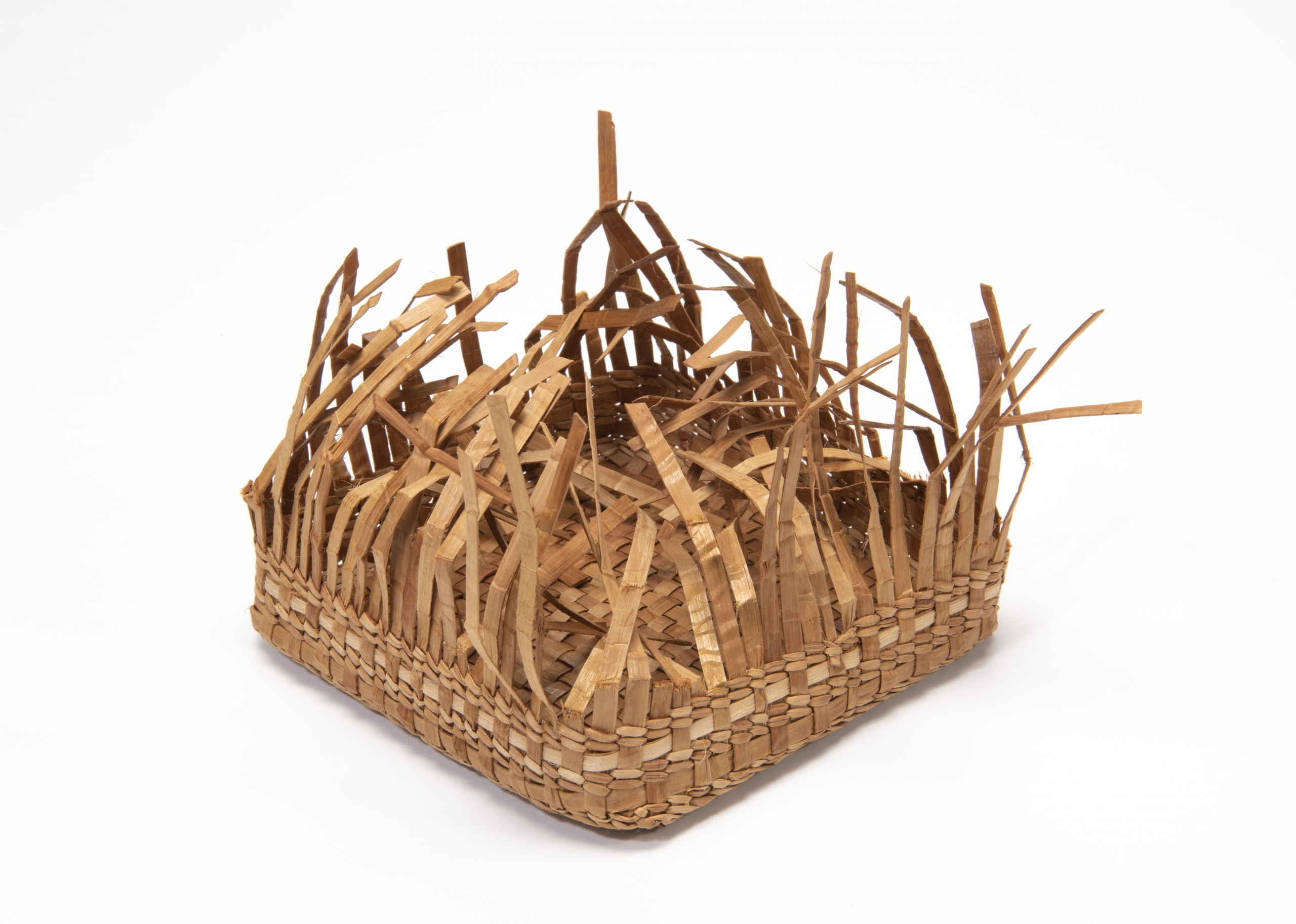Cedar-bark Basket in Progress
Artifact
Image
Video
Audio
 Activities
Activities
LOOK
Look at the xayna (cedar-bark basket) at different stages in its creation. How would you explain the steps involved in the weaving process, using your own words?
Extension: Watch the video From Spruce Roots to Baskets With a Haida Weaver. Was your explanation similar to Ariane’s?
THINK
What other kinds of weaving might use a similar process? Do some research to find out.
Hint: Think about other styles of weaving that might use different materials, or come from different parts of the world.
Details
 Materials
Materials - Cedar Bark
Historical Context
Choose one of the three levels below to match your needs.
- This xayna (basket) was woven in stages by Xaayda (Haida) artist Jiixa (Gladys Vandal) for the Canadian Museum of History.
- Here we see the different stages in the basket-weaving process: the cedar-bark strips, the base of the basket, the basket almost completed and the finished product.
- Traditionally, jaada (women) have gathered, processed and woven cedar bark.
Xaayda (Haida) artist Jiixa (Gladys Vandal) made this xayna (basket) in stages.
Traditionally, jaada (women) have been responsible for weaving, and have passed down their techniques to their daughters. They follow these general steps:
- Ts’uu k’al halxa (gather cedar-bark strips) from trees and separate the inner bark from the outer bark. Only the inner bark is used in weaving.
- Create a base for the basket. Here, Jiixa (Mrs. Vandal) used a ts’isdala (checkerboard or plaited) weave.
- Turn up the warp strands and adjust the tension of the weft strands to create the corners.
- Finish the basket by cutting or tucking in the ends of the warp strands.
Xaayda (Haida) artist Jiixa (Gladys Vandal) made this xayna (basket) for the Canadian Museum of History. These photos show the different stages of the creation process.
First, Jiixa (Mrs. Vandal) ts’uu k’al halxa (gathered cedar-bark strips) in the spring. It is usually jaada (women) who gather and process the bark for weaving. It is important to take strips from tall, straight trees, and to avoid taking too much bark, which could kill the tree. The outer layer has to be separated from the inner layer, the only one used in weaving. This inner layer must then be further processed by splitting and shredding, to make the strands easy to work with.
Second, Jiixa (Mrs. Vandal) created the base. In this case, she used a ts’isdala (checkerboard or plaited) weave.
Third, Jiixa (Mrs. Vandal) turned up the warp (vertical) strands, and adjusted the tension of the weft (horizontal) strands to create the corners. All weaving involves warp and weft strands. The weaver uses the warps to create the structure of the piece, and then weaves the wefts around the warps.
Last, to finish the basket, the ends can either be cut, or tucked into the last row.
- This xayna (basket) was woven in stages by Xaayda (Haida) artist Jiixa (Gladys Vandal) for the Canadian Museum of History.
- Here we see the different stages in the basket-weaving process: the cedar-bark strips, the base of the basket, the basket almost completed and the finished product.
- Traditionally, jaada (women) have gathered, processed and woven cedar bark.
Xaayda (Haida) artist Jiixa (Gladys Vandal) made this xayna (basket) in stages.
Traditionally, jaada (women) have been responsible for weaving, and have passed down their techniques to their daughters. They follow these general steps:
- Ts’uu k’al halxa (gather cedar-bark strips) from trees and separate the inner bark from the outer bark. Only the inner bark is used in weaving.
- Create a base for the basket. Here, Jiixa (Mrs. Vandal) used a ts’isdala (checkerboard or plaited) weave.
- Turn up the warp strands and adjust the tension of the weft strands to create the corners.
- Finish the basket by cutting or tucking in the ends of the warp strands.
Xaayda (Haida) artist Jiixa (Gladys Vandal) made this xayna (basket) for the Canadian Museum of History. These photos show the different stages of the creation process.
First, Jiixa (Mrs. Vandal) ts’uu k’al halxa (gathered cedar-bark strips) in the spring. It is usually jaada (women) who gather and process the bark for weaving. It is important to take strips from tall, straight trees, and to avoid taking too much bark, which could kill the tree. The outer layer has to be separated from the inner layer, the only one used in weaving. This inner layer must then be further processed by splitting and shredding, to make the strands easy to work with.
Second, Jiixa (Mrs. Vandal) created the base. In this case, she used a ts’isdala (checkerboard or plaited) weave.
Third, Jiixa (Mrs. Vandal) turned up the warp (vertical) strands, and adjusted the tension of the weft (horizontal) strands to create the corners. All weaving involves warp and weft strands. The weaver uses the warps to create the structure of the piece, and then weaves the wefts around the warps.
Last, to finish the basket, the ends can either be cut, or tucked into the last row.
Summary
- This xayna (basket) was woven in stages by Xaayda (Haida) artist Jiixa (Gladys Vandal) for the Canadian Museum of History.
- Here we see the different stages in the basket-weaving process: the cedar-bark strips, the base of the basket, the basket almost completed and the finished product.
- Traditionally, jaada (women) have gathered, processed and woven cedar bark.
Essential
Xaayda (Haida) artist Jiixa (Gladys Vandal) made this xayna (basket) in stages.
Traditionally, jaada (women) have been responsible for weaving, and have passed down their techniques to their daughters. They follow these general steps:
- Ts’uu k’al halxa (gather cedar-bark strips) from trees and separate the inner bark from the outer bark. Only the inner bark is used in weaving.
- Create a base for the basket. Here, Jiixa (Mrs. Vandal) used a ts’isdala (checkerboard or plaited) weave.
- Turn up the warp strands and adjust the tension of the weft strands to create the corners.
- Finish the basket by cutting or tucking in the ends of the warp strands.
In-Depth
Xaayda (Haida) artist Jiixa (Gladys Vandal) made this xayna (basket) for the Canadian Museum of History. These photos show the different stages of the creation process.
First, Jiixa (Mrs. Vandal) ts’uu k’al halxa (gathered cedar-bark strips) in the spring. It is usually jaada (women) who gather and process the bark for weaving. It is important to take strips from tall, straight trees, and to avoid taking too much bark, which could kill the tree. The outer layer has to be separated from the inner layer, the only one used in weaving. This inner layer must then be further processed by splitting and shredding, to make the strands easy to work with.
Second, Jiixa (Mrs. Vandal) created the base. In this case, she used a ts’isdala (checkerboard or plaited) weave.
Third, Jiixa (Mrs. Vandal) turned up the warp (vertical) strands, and adjusted the tension of the weft (horizontal) strands to create the corners. All weaving involves warp and weft strands. The weaver uses the warps to create the structure of the piece, and then weaves the wefts around the warps.
Last, to finish the basket, the ends can either be cut, or tucked into the last row.




